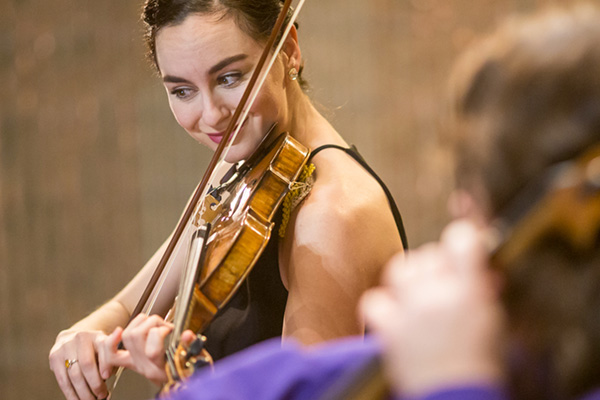Concert Review: Chameleon Arts Ensemble Explores the Bounties of the Belle Époque
By Aaron Keebaugh
The Chameleon Arts Ensemble shed new light on Ernest Chausson’s quartet in A major, Op. 30, the very model of Belle Époque verve and melodicism.

The Chameleon Arts Ensemble in action. Photo: courtesy of CAE
By the early 1890s, Ernest Chausson had grown weary of the Wagnerian fever that had infected contemporary French music. So, he set out to “de-Wagnerize” his own compositional voice.
Forging a new path led him to take a glance at what had come before. Pouring over the scores of Rameau and Couperin, he stripped his style to the bone. Gone were the emotional depths and swirling mists he had explored in his Symphonie, Op. 20, opera Le roi Arthus, and early chamber music. The crux of this new effort resulted in the greatest of his final works, the Piano Quartet in A major, Op. 30, the very model of Belle Époque verve and melodicism.
Yet for all its ebullience, the score still hovers at the edges of the repertoire, rarely surfacing on concert programs. Fortunately, the Chameleon Arts Ensemble shed new light on the quartet in their recent season-opening program at First Church in Boston.
Listening to Chausson’s quartet is to hear a singular moment in time where different musical paths converge. Flowering melodies reflect a Germanic zest that is echoed in the orchestral-like textures. Moods also change on a dime, often with archetypal romantic fervor. Still, a wistfulness frequently bubbles to the surface. It’s as if the composer were summing up the effects of Franck and Massenet while simultaneously looking ahead to the Impressionism of Debussy and Ravel.
The Chameleon Arts Ensemble played the work with utmost sensitivity. Lines in the outer movements swept by like wind on the plains. There was plenty of momentum too. The musicians were like skilled actors, building varied tensions with dramatic synergy.
The middle movements flowed with honeyed sweetness that never dipped into sentimentality. Anchored by pianist Alice Chenyang Xu, the strings made the “Très calme” flicker by blissfully. They simply glowed in the “Simple et sans hâte,” where the waltzes lilted with supple vitality.
All came to fruition in the coda. Played with panache, themes from the work’s opening reemerged like memories rushing to the surface. As relayed by the Chameleons, the essence of Chausson’s art is about making the past as immediate as the present.
Zoltán Kodály etched a similar Proustian effect in his Duo for Violin and Cello. Cast in three movements, this score makes a virtuosic display out of folk-like melodies and the composition was played with the verve of country fiddlers by violinist Francesca dePasquale and cellist Sarah Rommel.
Each mirrored the other with earthy vibrancy: dePasquale’s line in the Allegro serioso was a silvery sheen against the deep mahogany of Rommel’s cello. Both rendered the Adagio with haunting distance before the final movement erupted in a rhapsodic play that barreled fittingly to its hard-won resolution.
Claude Debussy’s Trois poèmes de Stéphane Mallarmé complemented with gentle solace.
Deborah Selig sang with supple nuance, teasing out the warm memories of “Soupir,” reveling in the coy and seductive sweep of “Placet futile,” and unleashing the bold, culminating power of “Éventail.” Pianist Vivian Chang-Freiheit was a sensitive partner, supporting Selig’s nimble soprano with both delicacy and assurance.
The only contemporary work on the program, Eric Moe’s Frozen Hours Melt Melodiously into the Past, makes a striking journey from darkness to true furor.
Scored for Pierrot ensemble (flute, clarinet, violin, viola, cello, and piano), Frozen Hours delivers an angular but searching 15 minutes. Through it all, the cello serves as a kind of ballast against waves of dissonance and fleeting stasis. Yet Moe’s music also compels through its wash of bold colors. Winds frame an opening cello line with icy harmonies. Strings answer with dark intensity before flute and piano tip the music briefly toward the light.
The Chameleons gave Frozen Hours a rapt performance that ensured that this attractive score would linger in the memory.
That was also the case with the brief opener, Lili Boulanger’s Nocturne et cortège. Working in ideal tandem, DePasquale and Chang-Freiheit packed fervent joy and longing in its taut five-minute expanse. Proof that even these delightful miniatures, in the hands of these extraordinary musicians, can convey impassioned exuberance.
Aaron Keebaugh has been a classical music critic in Boston since 2012. His work has been featured in the Musical Times, Corymbus, Boston Classical Review, Early Music America, and BBC Radio 3. A musicologist, he teaches at North Shore Community College in both Danvers and Lynn.

